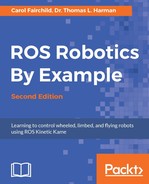In this chapter, we will introduce the Robot Operating System (ROS), which is a collection of software packages to aid researchers and developers using robotic systems. After we discuss the instructions to install ROS on your computer system using the Ubuntu operating system, the ROS architecture and many of its components are discussed. This will aid you in understanding the use of ROS to develop software for robotic applications.
ROS will be introduced in terms of its elements and their functions. An understanding of the ROS vocabulary is necessary to become proficient in using ROS to create programs for the control of real or simulated robots as well as devices, such as cameras.
To make the discussion more concrete, the turtlesim simulator will be presented with various examples of the ROS command usage. This simulator is part of ROS and it provides an excellent introduction to the capabilities of ROS.
In this chapter, we will cover the following topics:
- What ROS is and which robots use ROS
- How to install and launch ROS on your computer
- How to navigate the ROS directories
- An introduction to ROS packages, nodes, and topics
- Examples of useful ROS commands
- How to use ROS commands with the turtlesim simulator
ROS is sometimes called a meta operating system because it performs many functions of an operating system, but it requires a computer's operating system such as Linux. One of its main purposes is to provide communication between the user, the computer's operating system, and equipment external to the computer. This equipment can include sensors, cameras, as well as robots. As with any operating system, the benefit of ROS is the hardware abstraction and its ability to control a robot without the user having to know all of the details of the robot.
For example, to move a robot's arms, a ROS command is issued or scripts in Python or C++ written by the robot designers cause the robot to respond as commanded. The scripts can, in turn, call various control programs that cause the actual motion of the robot's arms. It is also possible to design and simulate your own robot using ROS. These subjects and many others will be considered in this book.
In this book, you will learn a set of concepts, software, and tools that apply to an ever-increasing and diverse army of robots. For example, the navigation software of one mobile robot can be used, with a few changes, to work in another mobile robot. The flight navigation of an aerial robot is similar to that of the ground robot and so on. All across the broad spectrum of robotics, system interfaces are standardized or upgraded to support increased complexity. There are readily available libraries for commonly used robotics functions. ROS not only applies to the central processing of robotics but also to sensors and other subsystems. ROS hardware abstraction combined with low-level device control speeds the upgrade toward the latest technology.
ROS is an open source robotic software system that can be used without licensing fees by universities, government agencies, and commercial companies. The advantages of open source software are that the source code for the system is available and can be modified according to a user's needs. More importantly for some users, the software can be used in a commercial product as long as the appropriate licenses are cited. The software can be improved and modules can be added by users and companies.
ROS is used by many thousands of users worldwide and knowledge can be shared between users. The users range from hobbyists to professional developers of commercial robots. In addition to the large group of ROS researchers, there is a ROS-Industrial group dedicated to applying ROS software to robots for manufacturing. Other versions of ROS currently under development include:
- ROS-M for military robotic systems
- H-ROS is Hardware ROS for interoperable robot components
- ROS 2.0 to upgrade ROS with the latest technology and software
A ROS distribution is a set of ROS software packages that can be downloaded to your computer. These packages are supported by the Open Source Robotics Foundation (OSRF), a nonprofit organization. The distributions are updated periodically and given different names by the ROS organization. More details about the ROS organization are available at: http://www.ros.org/about-ros/
